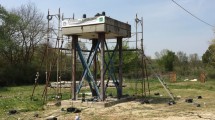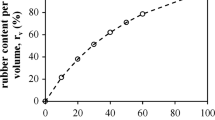Abstract
This study examines the use of granular soils mixed with tire derived aggregates (TDA) as an underlying soil layer for surface foundations. The benefit of this geotechnical seismic isolation (GSI) scheme is threefold: the seismic force and displacement are significantly reduced; the construction is similar to that of a regular compacted granular fill and the re-use of scrap tires has an assertive environmental impact. These features highlight the rubber/soil mixtures (RSM) as a promising seismic isolation technique for infrastructure and large-scale structures. The seismic isolation capabilities of a rubber-soil foundation layer are investigated, using well defined material properties, and the direct analysis method of the soil-structure system, in the form of a simple oscillator on a soil profile. The influence of the RSM layer on the fundamental variables of the seismic response, namely the base shear and the total drift displacement of the structure on deformable soil, is examined. The structure’s overall stability is studied by means of monotonic lateral load analysis and incremental dynamic analysis, varying the slenderness of the structure and the synthesis of the mixture. The effectiveness and capabilities of the RSM isolation scheme are presented and discussed.
Similar content being viewed by others
References
Ambraseys NN and Douglas J (2003), “Near-Field Horizontal and Vertical Earthquake Ground Motions,” Soil Dynamics and Earthquake Engineering, 23: 1–18.
Anastasopoulos I, Gazetas G, Loli M, Apostolou M and Gerolymos N (2010), “Soil Failure Can Be Used for Seismic Protection of Structures,” Bull Earthq Eng, 8(2): 309–26.
Apostolou M, Gazetas G and Garini E (2007), “Seismic Response of Slender Rigid Structures with Foundation Uplifting,” Soil Dynamics and Earthquake Engineering, 27(7): 642–654.
ASTM D4767-11 (2011), Standard Test Method for Consolidated Undrained Triaxial Compression Test for Cohesive Soils, ASTM International, West Conshohocken, PA, 2011, www.astm.org.
ASTM D6270-08 (2008), Standard Practice for Use of Scrap Tires in Civil Engineering Applications, ASTM International, West Conshohocken, PA, www.astm.org.
Bandyopadhyay S, Sengupta A and Reddy GR (2015), “Performance of Sand and Shredded Rubber Tire Mixture as a Natural Base Isolator for Earthquake Protection,” Earthquake Engineering and Engineering Vibration, 14(4): 683–693. https://doi.org/10.1007/s11803-015-0053-y.
Bardet JP, Ichii K and Lin CH (2000), EERA: A Computer Program for Equivalent-Linear Earthquake Site Response Analyses of Layered Soil Deposits, University of Southern California, Los Angeles, 2000.
Bertero V (1980), “Strength and Deformation Capacities of Buildings under Extreme Environments,” in Karl S. Pister, editor, Structural Engineering and Structural Mechanics A Volume Honoring Egor R. Popov, 188–237, Prentice Hall, Inc., Englewood Cliffs, N.J.
Bolisetti C and Whittaker AS (2015), “Site Response, Soil-Structure Interaction and Structure-Soil-Structure Interaction for Performance Assessment of Buildings and Nuclear Structures,” Technical Report MCEER-15-0002, University at Buffalo, State University of New York.
Bowles JE (1988), Foundation Analysis and Design, New York: McGraw-Hill.
Bray J and Rodriguez-Marek A (2004), “Characterization of Forward-Directivity Ground Motions in the Near-Fault Region,” Soil Dynamics and Earthquake Engineering, 24(2004): 815–828.
Brunet S, de la Llera JC and Kausel E (2016), “NonLinear Modeling of Seismic Isolation Systems Made of Recycled Tire-Rubber,” Soil Dynamics and Earthquake Engineering, 85: 134–145.
Castellano MG, Colato GP, Infanti S and Borella R (2012), “Seismic Isolation of Continuous Bridges Through Curved Surface Sliders Combined with Shock Transmission Units,” Proceedings of the 15th WCEE, Lisbon, Portugal.
CEN (2010), Materials Produced from End of Life Tyres — Specification of Categories Based on Their Dimension(s) and Impurities and Methods for Determining Their Dimension(s) and Impurities, European Committee for Standardization, CEN/TS 14243:2010, Brussels.
Chopra A and Chintanapakdee C (2001), “Comparing Response of SDF Systems to Near-Fault and Far-Fault Earthquake Motions in the Context of Spectral Regions,” Earthquake Engineering and Structural Dynamics, 30: 1769–1789. (DOI: https://doi.org/10.1002/eqe.92)
Chopra AK (1995), Dynamics of Structures: Theory and Applications to Earthquake Engineering, Englewood Cliffs, N.J., Prentice Hall.
Fonseca J, Riaz A, Bernal-Sanchez J, Barreto D, McDougall J, Miranda-Manzanares M, Marinelli A and Dimitriadi V (2019), “Particle-Scale Interactions and Energy Dissipation Mechanisms in Sand-Rubber Mixtures,” Géotechnique Letters9: 1–6, https://doi.org/10.1680/jgele.18.00221.
Gazetas G (1991), “Formulas and Charts for Impedances of Surface and Embedded Foundations,” Journal of Geotechnical Engineering Division, ASCE, 117(9): 1363–1381.
Gazetas G (2015), “4th Ishihara Lecture: Soil-Foundation-Structure Systems Beyond Conventional Seismic Failure Thresholds,” Soil Dynam Earthq Eng, 68: 23–39.
Gelagoti F, Kourkoulis R, Anastasopoulos I and Gazetas G (2012), “Rocking Isolation of Low-Rise Frame Structures Founded on Isolated Footings,” Earthq Eng Struct Dyn, 41(7): 1177–1197.
Gerolymos N, Apostolou M and Gazetas G (2005), “Neural Network Analysis of Overturning Response Under Near-Fault Type Excitation,” Earthquake Engineering and Engineering Vibration, 4(2): 213–228. https://doi.org/10.1007/s11803-005-0004-0.
Hataf N and Rahimi MM (2006), “Experimental Investigation of Bearing Capacity of Sand Reinforced with Randomly Distributed Tire Shreds,” Construction and Building Materials, 20(10): 910–916. https://doi.org/10.1016/j.conbuildmat.2005.06.019.
Hillerborg A, Modeer M and Petersson PE (1976), “Analysis of Crack Formation and Crack Growth in Concrete by Means of Fracture Mechanics and Finite Elements,” Cement and Concrete Research, 6: 773–782.
Jain SK (1989), “Introduction to Theories of Plasticity Part 1: Stress-Strain Relations,” Engineering Publications, Blacksburg Virginia.
Jirásek M and Rolshoven S (2003), “Comparison of Integral-Type Nonlocal Plasticity Models for Strain-Softening Materials,” International Journal of Engineering Science, 41(13–14): 1553–1602.
Khanmohammadi M and Mohsenzadeh V (2018), “Effects of Foundation Rocking and Uplifting on Displacement Amplification Factor,” Earthquake Engineering and Engineering Vibration, 17(3): 511–525. https://doi.org/10.1007/s11803-018-0459-4.
Kramer SL (1996), Geotechnical Earthquake Engineering, Prentice Hall, Upper Saddle River, N.J.
Lazari M, Sanavia L and Schrefler BA (2015), “Local and Non-Local Elasto-Viscoplasticity in Strain Localization Analysis of Multiphase Geomaterials,” International Journal for Numerical and Analytical Methods in Geomechanics, 39: 1570–1592.
Lee C, Shin H and Lee JS (2014), “Behavior of Sand-Rubber Particle Mixtures: Experimental Observations and Numerical Simulations,” Int. J. Numer. Anal. Meth. Geomech, 38: 1651–1663.
Makris M and Roussos Y (2000), “Rocking Response of Rigid Blocks under Near-Source Ground Motions,” Geotechnique, 50(3): 243–262.
Mavronicola E, Komodromos P and Charmpis DC (2010), “Numerical Investigation of Potential Usage of Rubber-Soil Mixtures as a Distributed Seismic Isolation Approach,” in B.H.V. Topping, J.M. Adam, F.J. Pallarés, R. Bru, M.L. Romero, editors, Proceedings of the Tenth International Conference on Computational Structures Technology, Civil-Comp Press, Stirlingshire, UK, Paper 168.
Mergos PE and Kawashima K (2005), “Rocking Isolation of a Typical Bridge pier on Spread Foundation,” J Earthq Eng, 9: 395–414.
Moghaddas Tafreshi SN and Norouzi AH (2012), “Bearing Capacity of a Square Model Footing on Sand Reinforced with Shredded Tire — An Experimental Investigation,” Construction and Building Materials, 35: 547–556. https://doi.org/10.1016/j.conbuildmat.2012.04.092i
Moghaddas Tafreshi SN, Joz Darabi N and Dawson A (2018), “Cyclic Loading Response of Footing on Multi-Layered Rubber-Soil Mixtures,” Geomechanics and Engineering, 14(2): 115–29.
Mylonakis G and Gazetas G (2000), “Seismic Soil-Structure Interaction: Beneficial or Detrimental?” J Earthq Eng, 4(3): 277–301.
Naeim F and Kelly JM (1999), Design of Seismic Isolated Structures: From Theory to Practice, Wiley, Chichester, England.
Pistolas GA (2015), “Experimental and Numerical Investigation of the Implementation of Recycled Materials Mixtures in the Foundation of Structures for the Improvement of Seismic Behavior,” PhD Dissertation, Department of Civil Engineering, Aristotle University of Thessaloniki, Greece. (in Greek)
Pistolas GA, Anastasiadis A and Pitilakis K (2014), “Mechanical Shear Strength Properties of Sand/Granulated Rubber Mixtures,” Proceedings of the 7th National Conference on Geotechnical Mechanics, Athens, Greece, paper XIV. 10. (in Greek)
Pistolas GA, Anastasiadis A and Pitilakis K (2018a), “Dynamic Behavior of Granular Soil Materials Mixed with Granulated Rubber: Effect of Rubber Content and Granularity on the Small-Strain Shear Modulus and Damping Ratio,” Geotech Geol Eng, 36: 1267. https://doi.org/10.1007/s10706-017-0391-9.
Pistolas GA, Anastasiadis A and Pitilakis K (2018b), “Dynamic Behavior of Granular Soil Materials Mixed with Granulated Rubber: Influence of Rubber Content and Mean Grain Size Ratio on Shear Modulus and Damping Ratio for a Wide Strain Range,” Innov. Infrastruct. Solut., 3: 47. https://doi.org/10.1007/s41062-018-0156-1.
Rathje EM, Faraj F, Russell S and Bray JD (2004), “Empirical Relationships for Frequency Content Parameters of Earthquake Ground Motions,” Earthquake Spectra, 20(1): 119–144.
SAC/FEMA (2000), “Recommended Seismic Design Criteria for New Steel Moment-Frame Buildings”, Report No. FEMA-350, SAC Joint Venture, Federal Emergency Management Agency, Washington, DC.
Shariatmadari N, Karimpour-Fard M and Shargh A (2018), “Undrained Monotonic and Cyclic Behavior of Sand-Ground Rubber Mixtures,” Earthquake Engineering and Engineering Vibration, 17(3): 541–553. https://doi.org/10.1007/s11803-018-0461-x.
Shen W, Zhu S, Zhu H and Xu Y (2016), “Electromagnetic Energy Harvesting from Structural Vibrations During Earthquakes,” Smart Structures and Systems, 18(3): 449–470.
Simulia (2012), “Abaqus User’s Manual,” Dassault Systèmes, Providence, RI, USA.
Skinner RI, Robinson WH and McVerry GH (1993), An Introduction to Seismic Isolation, Wiley, Chichester, England.
Sluys LJ, de Borst R and Mühlhaus HB (1993), “Wave Propagation, Localisation and Dispersion in Softening Solids,” International Journal of Solids and Structures, 30(9): 1153–1171.
Spyrakos CC, Maniatakis CA and Taflambas J (2014), “A Critical Evaluation of Near-Field Seismic Records in Greece,” WIT Transactions on State of the Art in Science and Engineering, WIT Press, 80. doi: https://doi.org/10.2495/978-1-84566-000-0/01
Stewart JP, Fenves GL and Seed RB (1999), “Seismic Soil-Structure Interaction in Buildings II: Empirical findings,” Journal Geotechnical and Geoenvironmental Engineering, 125: 38–48.
Stewart JP, Kwok AO, Hashash YMA, Matasovic N, Pyke R, Wang Z and Yang Z (2008), “Benchmarking of Nonlinear Geotechnical Ground Response Analysis Procedures,” Report PEER 2008/04, Pacific Earthquake Engineering Research Center, University of California, Berkeley.
Trifunac MD and Todorovska MI (1998), “Nonlinear Soil Response as a Natural Passive Isolation Mechanism-The 1994 Northridge, California Earthquake,” Soil Dynamics and Earthquake Engineering, 17(1): 41–51.
Tsang HH (2008), “Seismic Isolation by Rubber-Soil Mixtures for Developing Countries,” Earthquake Engineering and Structural Dynamics, 37(2): 283–303.
Tsang HH (2009), “Geotechnical Seismic Isolation,” Earthquake Engineering: New Research, New York, U.S. Nova Science Publishers Inc, 55–87.
Tsang HH and Pitilakis K (2019), “Mechanism of Geotechnical Seismic Isolation System: Analytical Modeling,” Soil Dynamics and Earthquake Engineering, 122: 171–184.
Tsang HH, Lo SH, Xu X and Sheikh MN (2012), “Seismic Isolation for Low-to-Medium-Rise Buildings Using Granulated Rubber-Soil Mixtures: Numerical Study,” Earthquake Engineering and Structural Dynamics, 41: 2009–2024.
Tselentis GA and Zahradnik J (2000), “The Athens Earthquake of 7 September 1999,” Bulletin of the Seismological Society of America, 90(5): 1143–1160.
Tsuda M, Kawasaki T, Yagai T and Hamajima T (2008), “Improvement of Levitation Force Characteristics in Magnetic Levitation Type Seismic Isolation Device Composed of HTS Bulk and Permanent Magnet,” Journal of Physics: Conference Series, 97: 012104.
Veletsos AS and Meek JW (1974), “Dynamic Behavior of Building-Foundation Systems”, Earthquake Engineering and Structural Dynamics, 3(2): 121–138.
Veletsos AS and Nair VV (1975), “Seismic Interaction of Structures on Hysteretic Foundations,” Journal of Structural Engineering, 101: 109–129.
Wilde K, Gardoni P and Fujino Y (2000), “Base Isolation System with Shape Memory Alloy Device for Elevated Highway Bridges,” Engineering Structures, 22(3): 222–229.
Wolf JP (1985), Dynamic Soil-Structure Interaction, Prentice-Hall, Engl. Cliffs, NJ.
Xiong W and Li Y (2013), “Seismic Isolation Using Granulated Tire-Soil Mixtures for Less-Developed Regions: Experimental Validation,” Earthquake Eng Struct. Dyn., 42: 2187–2193.
Yaghmaei-Sabegh S and Tsang HH (2011), “An Updated Study on Near-Fault Ground Motions of the 1978 Tabas, Iran, Earthquake (Mw = 7.4),” Scientia Iranica A, 18(4): 895–905.
Yoshioka H, Ramallo JC and Spencer BF Jr (2002), “‘Smart’ Base Isolation Strategies Employing Magnetorheological Dampers,” Journal of Engineering Mechanics, 128(5). ISSN 0733–9399/2002/5-540-551.
Zienkiewicz OC, Bicanic N and Shen FQ (1989), “Earthquake Input Definition and the Transmitting Boundary Conditions,” in Doltsinis I.S., editor, Advances in Computational Nonlinear Mechanics, International Centre for Mechanical Sciences (Courses and Lectures), vol. 300, Springer, Vienna.
Author information
Authors and Affiliations
Corresponding author
Rights and permissions
About this article
Cite this article
Pistolas, G.A., Pitilakis, K. & Anastasiadis, A. A numerical investigation on the seismic isolation potential of rubber/soil mixtures. Earthq. Eng. Eng. Vib. 19, 683–704 (2020). https://doi.org/10.1007/s11803-020-0589-3
Received:
Accepted:
Published:
Issue Date:
DOI: https://doi.org/10.1007/s11803-020-0589-3




